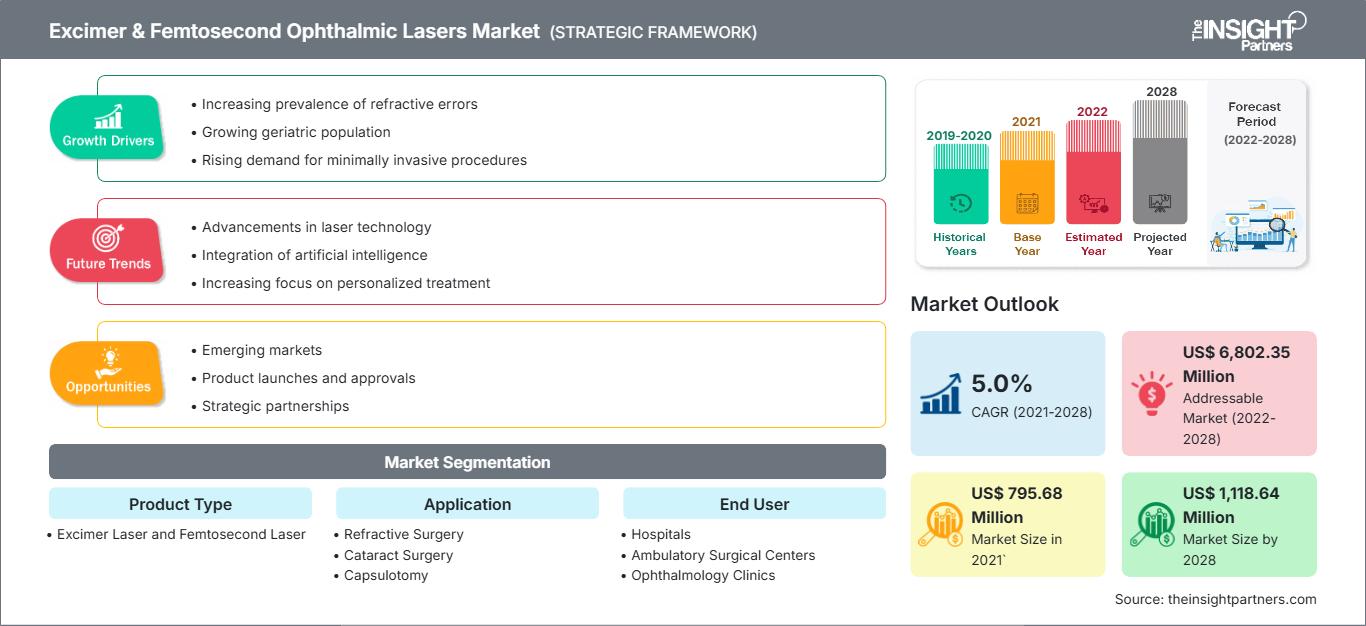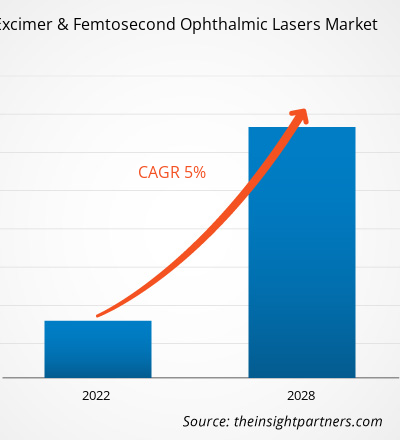Der Markt für Excimer- und Femtosekunden-Augenlaser soll von 795,68 Millionen US-Dollar im Jahr 2021 auf 1.118,64 Millionen US-Dollar im Jahr 2028 anwachsen; für den Zeitraum von 2021 bis 2028 wird mit einer durchschnittlichen jährlichen Wachstumsrate von 5,0 % gerechnet.
Berichtsumfang
Das Wachstum des Marktes für Excimer- und Femtosekunden-Ophthalmologielaser wird Faktoren wie der zunehmenden älteren Bevölkerung und der Zunahme von Katarakt- und refraktiven Operationen zugeschrieben. Die hohen Kosten für augenärztliche Operationen und Geräte hemmen jedoch das Wachstum des Marktes.
Passen Sie diesen Bericht Ihren Anforderungen an
Sie erhalten kostenlos Anpassungen an jedem Bericht, einschließlich Teilen dieses Berichts oder einer Analyse auf Länderebene, eines Excel-Datenpakets sowie tolle Angebote und Rabatte für Start-ups und Universitäten.
Markt für Excimer- und Femtosekunden-Ophthalmologielaser: Strategische Einblicke

-
Holen Sie sich die wichtigsten Markttrends aus diesem Bericht.Dieses KOSTENLOSE Beispiel umfasst Datenanalysen, die von Markttrends bis hin zu Schätzungen und Prognosen reichen.
Markteinblicke
Deutlicher Anstieg der älteren Bevölkerung
Der Anstieg der geriatrischen Bevölkerung in Ländern wie den USA, Großbritannien, Kanada, Japan, China, Indien und Südkorea wird durch die Modernisierung der Gesundheitseinrichtungen und Verbesserungen der Gesundheitsdienste vorangetrieben, was die Lebenserwartung in diesen Ländern erhöht. Laut Daten der WHO vom Februar 2018 wird der Anteil der geriatrischen Bevölkerung voraussichtlich von 12 % im Jahr 2015 auf 22 % im Jahr 2050 steigen. Laut dem US Census Bureau wird die Zahl der Menschen in den USA im Alter von 65 Jahren und älter voraussichtlich von 46 Millionen im Jahr 2016 auf über 98 Millionen im Jahr 2060 steigen, während ihr Bevölkerungsanteil in diesem Zeitraum von ~15 % auf ~24 % steigen wird. Laut dem Bericht der Vereinten Nationen zur Alterung der Weltbevölkerung 2017 hatte Europa im Jahr 2017 den weltweit höchsten Anteil (nämlich 25 %) an Menschen über 60 Jahren. Darüber hinaus werden bis 2050 in allen Regionen der Welt außer Afrika mindestens 25 % der Bevölkerung 60 Jahre oder älter sein, und auf unterentwickelte Länder und Entwicklungsländer wird dieser Anteil für etwa 80 % liegen.
Der Verlust des Sehvermögens ist ein großes Gesundheitsproblem bei älteren Menschen. Altersbedingte Makuladegeneration, grüner Star, grauer Star und diabetische Retinopathie gehören zu den häufigsten Ursachen für Sehverlust bei Menschen dieser Altersgruppe. Altersbedingte Makuladegeneration führt zum Verlust des zentralen Sehvermögens. Eine Schädigung des Sehnervs und ein Verlust des Gesichtsfelds können als Folge eines primären Offenwinkelglaukoms auftreten. Da diese Erkrankung zunächst asymptomatisch verlaufen kann, sind regelmäßige Kontrolluntersuchungen für ältere Menschen erforderlich. Obwohl der Graue Star die häufigste Ursache für Sehprobleme bei diesen Menschen ist, kann er normalerweise durch einen chirurgischen Eingriff entfernt werden. Diabetische Retinopathie kommt auch bei älteren Menschen im Frühstadium von Diabetes oder zum Zeitpunkt der Diagnose häufig vor. Wird bei einem Patienten Diabetes diagnostiziert, wird eine mydriatische Untersuchung empfohlen, gefolgt von einer jährlichen Kontrolluntersuchung.
Dem American Institute of Ophthalmology zufolge unterziehen sich etwa 24,4 Millionen Menschen unter 40 Jahren einer Kataraktoperation, und etwa 5 % aller Amerikaner unterziehen sich bis zum Alter von 75 Jahren einer Kataraktoperation. Darüber hinaus nimmt die Zahl der Glaukomfälle zu und betrifft über 2,7 Millionen Amerikaner im Alter von 40 Jahren und älter. Neue Augenkrankheiten wie die altersbedingte Makuladegeneration, von der über 2,1 Millionen Amerikaner im Alter von 50 Jahren und älter betroffen sind, können zu schwerem Sehverlust führen. Daher werden neue Technologien wie Femtosekundenlaser in der Kataraktchirurgie sehr häufig eingesetzt, was zwar hohe Anfangsinvestitionen erfordert, aber Verbesserungen der Patientenergebnisse verspricht. Der Anstieg der geriatrischen Bevölkerung treibt somit das Wachstum des Marktes für Excimer- und Femtosekunden-Augenlaser voran.
Produkttypbasierte Erkenntnisse
Basierend auf dem Produkttyp ist der Markt für Excimer- und Femtosekunden-Augenlaser in Excimerlaser und Femtosekundenlaser unterteilt. Das Segment der Femtosekundenlaser wird voraussichtlich im Jahr 2021 den Markt anführen und seine beherrschende Stellung zwischen 2021 und 2028 behalten. Darüber hinaus wird dasselbe Segment in den kommenden Jahren voraussichtlich am schnellsten wachsen.
Anwendungsbasierte Erkenntnisse
Basierend auf der Anwendung werden Excimer- und Der Markt für Femtosekunden-Ophthalmolaser ist in die Bereiche Refraktive Chirurgie, Kataraktchirurgie, Kapsulotomie, Trabekuloplastik und Diagnostik unterteilt. Das Segment Refraktive Chirurgie wird voraussichtlich 2021 den größten Marktanteil halten, während das Segment Kataraktchirurgie im Prognosezeitraum voraussichtlich die höchste CAGR auf dem Markt verzeichnen wird.
Endnutzerbasierte Erkenntnisse
Basierend auf dem Endnutzer ist der Markt für Excimer- und Femtosekunden-Ophthalmolaser in Krankenhäuser, Augenkliniken und ambulante Operationszentren unterteilt. Das Segment Krankenhäuser wird voraussichtlich 2021 den größten Marktanteil halten. Das Segment Augenkliniken wird jedoch im Prognosezeitraum voraussichtlich die höchste CAGR auf dem Markt verzeichnen.
Produkteinführungen und -zulassungen sind die von Unternehmen häufig verfolgten Strategien, um ihre globale Präsenz und ihr Produktportfolio zu erweitern. Unternehmen im Bereich Excimer- und Der Markt für Femtosekunden-Augenlaser konzentriert sich auf die Kooperationsstrategie, um seinen Kundenstamm zu erweitern, was ihm wiederum ermöglicht, seinen Markennamen weltweit zu behaupten.
Markt für ophthalmologische Excimer- und Femtosekundenlaser
Die Analysten von The Insight Partners haben die regionalen Trends und Faktoren, die den Markt für Excimer- und Femtosekunden-Ophthalmologielaser im Prognosezeitraum beeinflussen, ausführlich erläutert. In diesem Abschnitt werden auch die Marktsegmente und die geografische Lage in Nordamerika, Europa, im asiatisch-pazifischen Raum, im Nahen Osten und Afrika sowie in Süd- und Mittelamerika erörtert.Umfang des Marktberichts zu Excimer- und Femtosekunden-Ophthalmologielasern
| Berichtsattribut | Einzelheiten |
|---|---|
| Marktgröße in 2021` | US$ 795.68 Million |
| Marktgröße nach 2028 | US$ 1,118.64 Million |
| Globale CAGR (2021 - 2028) | 5.0% |
| Historische Daten | 2019-2020 |
| Prognosezeitraum | 2022-2028 |
| Abgedeckte Segmente |
By Produkttyp
|
| Abgedeckte Regionen und Länder |
Nordamerika
|
| Marktführer und wichtige Unternehmensprofile |
|
Marktdichte der Excimer- und Femtosekunden-Augenlaser: Auswirkungen auf die Geschäftsdynamik verstehen
Der Markt für Excimer- und Femtosekunden-Ophthalmologielaser wächst rasant. Dies wird durch die steigende Endverbrauchernachfrage aufgrund veränderter Verbraucherpräferenzen, technologischer Fortschritte und eines stärkeren Bewusstseins für die Produktvorteile vorangetrieben. Mit der steigenden Nachfrage erweitern Unternehmen ihr Angebot, entwickeln Innovationen, um den Bedürfnissen der Verbraucher gerecht zu werden, und nutzen neue Trends, was das Marktwachstum weiter ankurbelt.
- Holen Sie sich die Markt für Excimer- und Femtosekunden-Ophthalmologielaser Übersicht der wichtigsten Akteure
Markt für Excimer- und Femtosekunden-Ophthalmologielaser – nach Produkttyp
- Femtosekundenlaser
- Excimer-Laser
Markt für Excimer- und Femtosekunden-Ophthalmologielaser – nach Anwendung
- Refraktive Chirurgie
- Kataraktchirurgie
- Kapsulotomie
- Trabekuloplastik
- Diagnostik
Markt für Excimer- und Femtosekunden-Ophthalmologielaser – nach Endverbraucher
- Krankenhäuser
- Augenkliniken
- Ambulante Operationszentren
Markt für Excimer- und Femtosekunden-Ophthalmologielaser – nach Geographie
- Nordamerika
- USA
- Kanada
- Mexiko
- Europa
- Frankreich
- Deutschland
- Italien
- Großbritannien
- Spanien
- Übriges Europa
- Asien-Pazifik (APAC)
- China
- Indien
- Südkorea
- Japan
- Australien
- Übriger Asien-Pazifik-Raum
- Naher Osten und Afrika (MEA)
- Südafrika
- Saudi-Arabien
- VAE
- Übriger Naher Osten und Afrika
- Süd- und Mittelamerika (Betrug)
- Brasilien
- Argentinien
- Rest von Süd- und Mittelamerika
Unternehmensprofile
- Bausch Health Companies Inc.
- Alcon Inc.
- ZEISS International
- NIDEK CO., LTD
- IVIS TECHNOLOGIES
- EXCELSIUS MEDICAL GMBH
- Ziemer Ophthalmic Systems
- SCHWIND EYE-TECH-SOLUTIONS
- LENSAR, Inc.
- NKT Photonics A/S
- Historische Analyse (2 Jahre), Basisjahr, Prognose (7 Jahre) mit CAGR
- PEST- und SWOT-Analyse
- Marktgröße Wert/Volumen – Global, Regional, Land
- Branchen- und Wettbewerbslandschaft
- Excel-Datensatz
Aktuelle Berichte
Verwandte Berichte
Erfahrungsberichte
Grund zum Kauf
- Fundierte Entscheidungsfindung
- Marktdynamik verstehen
- Wettbewerbsanalyse
- Kundeneinblicke
- Marktprognosen
- Risikominimierung
- Strategische Planung
- Investitionsbegründung
- Identifizierung neuer Märkte
- Verbesserung von Marketingstrategien
- Steigerung der Betriebseffizienz
- Anpassung an regulatorische Trends






















 Kostenlose Probe anfordern für - Markt für Excimer- und Femtosekunden-Ophthalmologielaser
Kostenlose Probe anfordern für - Markt für Excimer- und Femtosekunden-Ophthalmologielaser